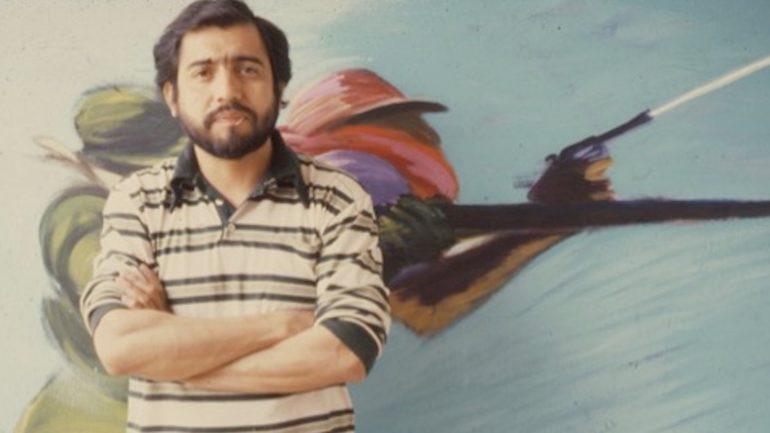Palm Springs Review: ‘Carlos Almaraz: Playing With Fire’
By Dennis Harvey
LOS ANGELES (Variety.com) – Though he passed away three decades ago, Carlos Almaraz’s reputation as a major American painter — which was just getting started when he died of AIDS in 1989 — promises to continue to gain traction with the years. Documentary tribute “Playing With Fire” by his fellow-artist widow Elsa Flores and Richard Montoya mostly transcends standard artist-appreciation terrain by virtue of a diverse, colorful and energetic package that amplifies the subject’s own aesthetic. The film would seem a natural fit for artscasters and other programmers, particularly those in search of Latino cultural relevance. Input from surviving admirers and friends like Edward James Olmos and Cheech Marin lend a certain marquee value.
After a somewhat conventional introduction, the movie gears up to present Almaraz’s life story in terms that are as busy, antic and assimilative as his art. Born in 1941 in Mexico City, he moved with his family as a child to the industrial midwest, then to Los Angeles. That compound identity as Mexican native, “melting pot” emigre and newcomer in the “fortress” of East L.A. Latino culture would prove primary to his work, even if early on, his greatest love was animation (and its king, Walt Disney).
Arriving as a young man in the wildly exciting New York City art landscape of the mid-’60s, he both fed on and felt at odds with the then-dominating vogue of minimalism, his instincts being more passionate and personal. After a couple of breakdowns exacerbated by alcohol abuse (which nearly killed him), he landed back in Southern California just as the Chicano Power Movement was gathering force. His work immediately became more overtly political and ethnically specific, lending itself to the agitprop needs of Cesar Chavez and Dolores Huerta (both interviewed here, the former in archival footage). His newly embraced Communist ideals led to the formation of a collective with three other leading Chicano male artists. “Los Four” attracted considerable attention, including the first Latino exhibit at a major U.S. museum (LACMA), but their clashing aims and egos made for a short-lived experiment.
In any case, Almaraz was at this point ready to express himself in more idiosyncratic terms than any political or artistic movement could allow. Insanely prolific, his skills now greatly honed, he “arrived” in commercial gallery terms with a series of violent yet oddly playful car-crash paintings that riffed on his L.A. environs as well as on a general sense of American excess. Like so many of his images, they made a jolting first impression underlaid with prankish humor and complex layers of meaning, as well as a ravishingly vivid color sense.
Various observers here compare him at times to the impressionists, Chagall, Diego Rivera and others, a sprawling assortment that nonetheless could duly be detected in his uniting of lyrical, political and pop elements. Though he’d tried his best (and failed) in New York to paint like a trendy abstract-minimalist, his voluminous mature work was emotional, passionate, often both rhapsodic and disquieting, not at all cold or theoretical.
Though note is made of darker periods and appetites, the film emphasizes Almaraz as a sunny dynamo who found his life balance at last upon marrying significantly younger artist Flores and fathering a daughter. At times one wonders how much this is an “authorized” view preferred by his widow, particularly as “Playing With Fire” seems a bit politely dismissive of his apparent primarily gay orientation earlier on, as if homosexuality or bisexuality were adverse conditions he eventually recovered from. Despite its title, the documentary presents the artist not as a self-destructive figure but a life force snuffed out far too soon, short of age 50.
Whether this is a definitive, balanced portrayal or not, it’s nonetheless an appealing one. Almaraz certainly seems happy in vintage footage, notably a 1980 video where he explains his artistic ethos while standing in front of a 12-foot canvas depicting a local burrito stand.
Fellow artists, activists, curators and others offer the requisite appreciations. But most of the film’s potency comes from the sheer force of its subject’s imagery, which sometimes come to life in flip-book form, at other times (and to more variable effect) via actual animation of drawings and paintings. Montoya (of the veteran performance trio Culture Clash) and Flores also interpolate a cleverly selected range of archival ephemera, including news clips, vintage ads and a wide-ranging soundtrack of pre-existing cuts. (Los Lobos’ Louie Perez contributes the original score.) As Almaraz absorbed and utilized elements in his environment for art’s sake, so does the film create a kind of careening collage-effect to capture his sensibility.

